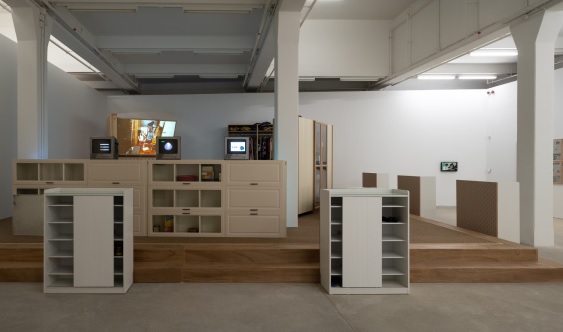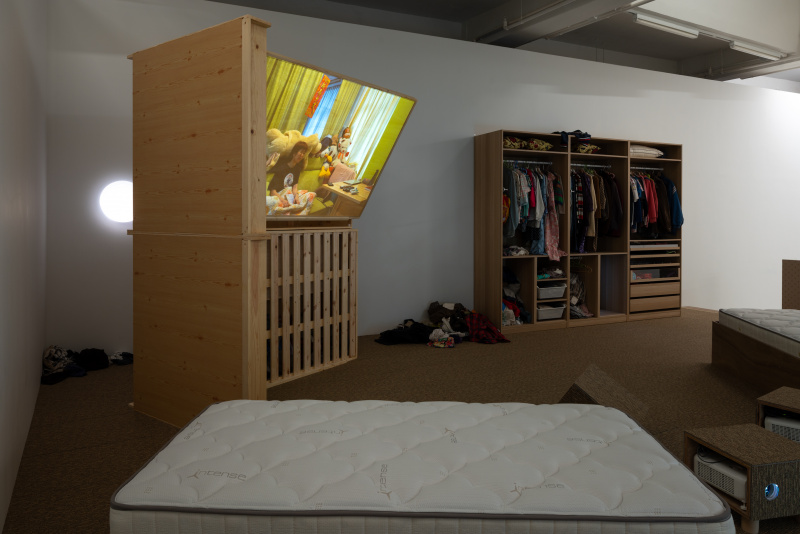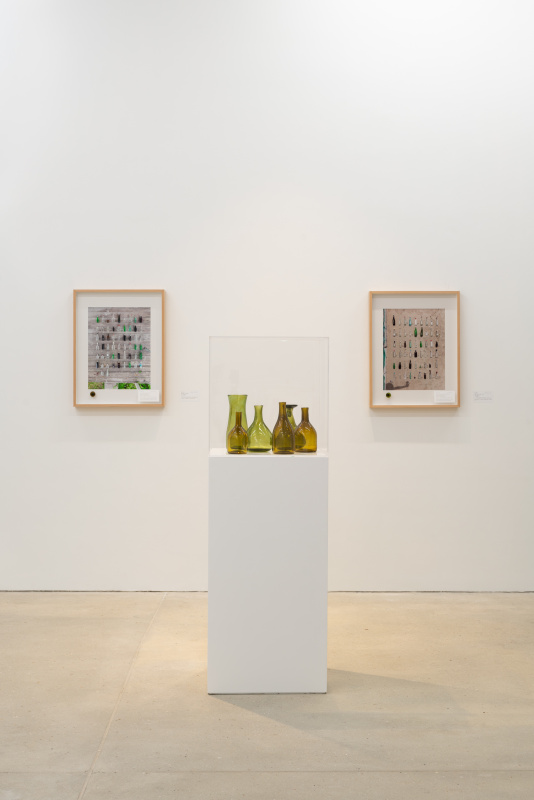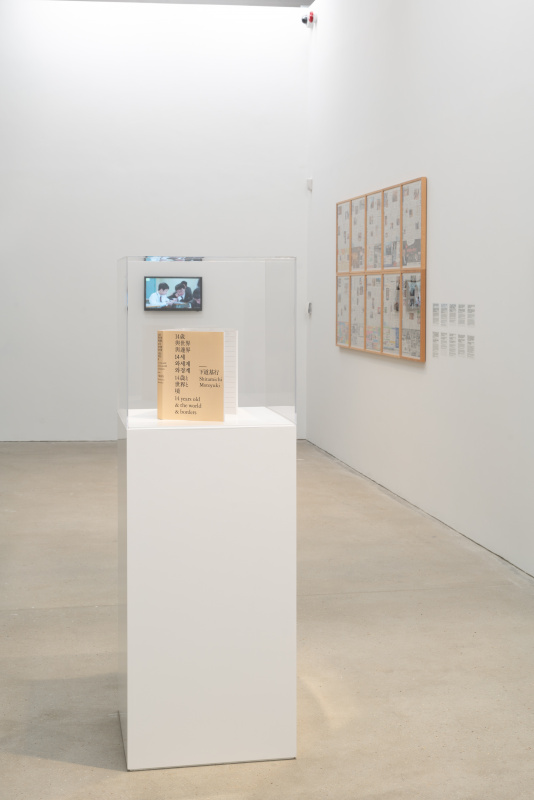新/另類藝術空間
- 天台塾Our Everyday – Our Borders: a review
楊陽 (Yang YEUNG)
at 1:11pm on 22nd December 2018




Captions:
1. - 2.Tang Kwok Hin, Every Pandiculate, 2018–now. Video installation, daily objects Dimensions variable
3. Motoyuki Shitamichi, Floating Monuments, 2014–now. Glass bottles, C-print.|
4. Motoyuki Shitamichi, 14 Years Old and World and Borders, 2018.
(原文以英文發表,評論「日常邊界」展。)
Of all that addresses ideas of the everyday and the border in Our Everyday – Our Borders, a crack in a brown glass bottle presents itself as unsettling. As I write, the crack is the only one in the six bottles that Motoyuki Shitamichi and Okinawan craftsmen made by melting glass the artist has collected from the beaches of Okinawa. Floating Monuments shows states of the bottles before and after the melting. Their incompatibility is assumed and embraced: they are now each other. The newly acquired potentiality of falling apart makes them unlike any other monument: they do not put time to a stop, but surrender to nature’s laws, its calls. Or, perhaps the bottles will prevail, but either way, they mark the movement of time, in time. The crack is unsettling for bringing indeterminateness.
Similarly, the state of ongoing transformation arises out of Tang Kwok-hin’s Every Pandiculate. In the gallery, it is an installation of divergent time lines: scenarios in videos give shape to some of them, while objects in situ pass through others. For instance, at the border of the installation are three videos showing such everyday objects as a paper clip, a soap, an audio cable that the artist has scanned by enveloping each one in a black plastic bag. The object is now blurred on the edge, but exposed as having a kernel waiting to burst out, thereby acquiring a brilliance against the unfathomable black. Diagonally away from these videos is an arrangement of flowers by one of the project’s participants. It is set on the floor, decaying in time. How many participants have there been? With an email open call, Tang began involving others, organizing gatherings in his home and the participants’ half a year before the exhibition opened. The call remains open. In the gallery, the volatility of their interaction beyond the structure are suspended. The count is kept but not told: it seems it is more important for the artist that they have become each other’s witnesses in life than in the gallery, and will continue to. In this light, the work is at once empty and full of a future untold.
Shitamichi’s second work 14 Years Old and World and Borders also registers futurity. Set in the blandness of a beige tone, 14 Years Old and World and Borders is a series of framed newspapers lined up on the wall in an even-tempered rhythm. Each page is punctuated by a small column carrying the transcript of a 14-year-old’s dream, which the artist collected in workshops that took place over the past year in Hong Kong and in 2013 in Japan. To properly read them, one needs to walk up close to the frame. Where a name is found, a voice is heard: Ko Hong Sek from Hong Kong, for instance, dreams to be a singer, a doctor or a rich person. Mok Lai Sim dreams to live in the countryside. Kazuya Jitsunari from Japan dreams to become an inventor, while Kota Mizukami dreams of the ‘outer-space-related’. Is the voice a whisper, a stutter, or a song? Does it come with a laugh, a choke, or a tremble? As if to regulate the idea of young people’s dreams being taken as clichés (considering how ‘childhood’ and ‘youth’ occasionally serve the rhetoric of consumerist culture and tactics of advertising), the artist puts much care in gathering them as individuated. Cup our ears, and the dreams sound out even clearer; they rupture the amalgam of adult information occupying the rest of the pages, stories from the past albeit the very recent past (which defines the business of the printed press). Shitamichi says he wants people who read the stories to “realise immediately that they are still kids inside.” [1] It is an invitation for and a prompt to awaken a self relation dependent on the affective attachment with others. I am reminded of Ernst Bloch, who says experience cannot work alone; dreams, as a training of the experience of deprivation and desiring to life, prepare for experience. [2]
The prospective nature of temporality in both artists’ work gives rise to a particular kind of space. In thinking about the quality of life, Amartya Sen and Martha Nussbaum argue, “The identification of the objects of value specifies what may be called an evaluative space. In standard utilitarian analysis, for example, the evaluative space consists of the individual utilities (defined in the usual terms of pleasures, happiness, or desire fulfilment).” [3] Their approach on the other hand, which they call the “capability approach”, “sees the evaluative space in terms of functionings and capabilities to function.” [4] To “function” is not to conform to what is pre-set in a system by human design, nor is it to produce utility. Rather, this idea of functioning goes back to Aristotle. He argues the function (Greek: ergon) of humans is the capacity to reason, employed to guide ourselves to a good life. It is when humans can flourish (Greek: eudaimonia, often reduced in its translation as ‘happiness’) in what they can that the excellence of the individual could be accomplished. [5] While Aristotle restricts the characteristic human function to reasoning, which is debatable, Sen and Nussbaum proposes that each individual has a different capabilities set, each set being valuable in itself and not a means to something else (eg. income to acquire goods, resources to achieve higher social status). Sen and Nussbaum’s evaluative space, therefore, “makes room for valuing various freedoms – in the form of capabilities”. [6]
That said, I find the artists presenting evaluative spaces that are even more nuanced than the theorists would have the reach for. They clear the ground so that processes of value formation can begin again, from wherever they have been interrupted. In Tang’s Every Pandiculate, the evaluative process is in the stage of incubation. It is directed relatively inward, to the artist first, by such questions as What does it mean for me to be an artist? How and how far could/ should the solitude of an artist be transformed? How much care does an artist need from others? They are questions that seek truth beyond convention. The evaluative process for and with participants comes as secondary, though no less important. Shitamichi’s 14 Years Old and World and Borders also conjures an evaluative space beyond established meanings. The evaluative process also begins from the artist self, which extends to others amongst whom he lives. Shitamichi says he chooses to listen to these young people’s dreams because “[he] could not see the landscape like a secondary school student does. Also they are in a difficult period, and it is not easy for them to open their hearts.” [7] In this light, his evaluative space is directed relatively outward to such questions as What circulates in everyday life that pushes the ‘minors’ to the side? How are we responsible for others’ dreams? It could be read as also advocacy attuned to the world.
What makes all these possible is in a large part, I would propose, to do with how the artist positions his sense of self. In a public talk, Tang says it’s hard not to think of himself as an artist, but since some time ago, as he finds himself waking up and seeing everything around him as an exhibition, he realizes it is time to change from thinking about art to thinking about life – everyday life. He distances himself from the obstinate and the conceited that occasionally burden the name of the “Artist”, while not letting go of how art has touched him and made him. For Shitamichi, “creativity comes out of the loss of some things.” [8] This reflection, he says, comes during his workshops with students about what separates things in their lives. I wonder if to lose is also to find, and to be found. His childhood dream of becoming an anthropologist has been somehow lost, but has also made its way into his art, his way of life. While Tang’s positioning may be situated in a more speculative stage, and Shitamichi’s, more toward the affirmative, both remain close to what art would claim – laying life bare. Both do so without antagonism or aggression. Both attend to not losing touch of others’ lives on art’s way. To do so, they let an ethics of listening bear upon themselves, motivating participants as desiring the same. One sees clearly in these gestures that artists, too, need care; being intimate with others offers them support. The need of intimacy is sometimes seen as a sign of weakness. I think it is also important to acknowledge that it is also an essential condition for nurturing a self-relation. This is the kind of artist self that is often left out in discourses of glamour and glory, price and market, autonomy and originality.
What makes these projects different from well-circulated ways of understanding socially-engaged art is that they present the socially-aspired and art-aspired as not conflicting nor compromising each other. There is no apology for what being an artist is and where it may fail, and there is no pressure for art to make social change. These humanizing gestures are more urgent as individual freedom is infringed upon by the depoliticized freedom of choices defined by utility and other forms of instrumentalization.
A dedication to the future without being stylistically futuristic, without feigning clairvoyance, Our Everyday – Our Borders inhabits a multitude of existing established borders only to show their permeability, thereby distributing hope of a kind that society fails to. Many have said that hope does not reside in optimism, the (false) belief that everything will turn out fine. It is instead by way of deliberating what makes life worth living – in all its incompleteness, that hope conjures, a sensibility Maxine Greene shares: "Only human beings can experience incompleteness, the gap between what is and what might be. Only human beings can fill the gap by moving out in search of meaning and transcendence, moving out to change their world. The focus must remain on the human being, on his or her achievement, his or her choice." [10]
It may even be possible to speak of the artists as safekeeping secrets for others and each other, for a future one can still take responsibility for.
Endnotes
[1] From email interview with artist, October 6, 2018. Unpublished.
[2] Ernst Bloch, The Principle of Hope, 3 volumes. Cambridge: MIT Press. 1995.
[3] Martha Nussbaum and Amartya Sen, “Capability and Well-Being” in The Quality of Life, Oxford University Press Scholarship Online. 2003: 4.
[4] ibid.
[5] See for instance, Richard Kraut, "Aristotle''s Ethics", The Stanford Encyclopedia of Philosophy (Summer 2018 Edition), Edward N. Zalta (ed.). https://plato.stanford.edu/archives/sum2018/entries/aristotle-ethics/
[6] Nussbaum and Sen, ibid.
[7] From email interview with artist, October 6, 2018. Unpublished.
[8] ibid.
[9] Arjun Appadurai, "The Capacity to Aspire: Culture and Terms of Recognition" in Culture and Public Action, ed. Vijayendra Rao and Michael Walton, 2004:82)
[10] Maxine Greene, Landscapes of Learning. New York: Teachers College, Columbia University. 1978.
This article was first published in CoBo Social, November 2018
原文刊於CoBo Social,2018年11月
